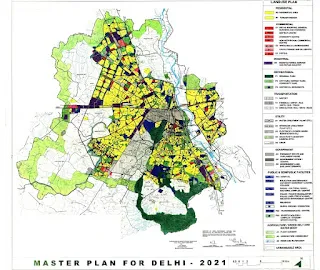The walled cities of ancient and medieval India stood apart from the surrounding rural areas. The limits of the physical city were then clearly defined by the walls, the moats and other protective structures around the city. Inside the walled city lived an urban class of people engaged in non-agricultural occupations, and in the villages outside the city, there lived rural people who were primarily engaged in agriculture and animal husbandry. The city and countryside were clearly divided by a discernable and conspicuous boundary-the city wall. Even where walls were absent, the boundary between the traditional Indian city and the rural villages was abrupt and clearly defined.
Even today, the boundaries of all towns, large and small, and some one-lakh cities as well, are clearly demarcated. Even a casual observer in these places would notice the point where the urban area abruptly gives away to areas of rural land-use.
The situation is very different in case of metropolitan cities and some of the larger one-lakh cities. Around these major urban centres, the physical expansion of built-up areas beyond their municipal boundaries has been very conspicuous. Much of this development has occurred in a spontaneous, haphazard and unplanned manner. What were essentially rural villages beyond the municipal limits have now been unmistakably transformed by the location of urban residential, commercial and industrial complexes. The city has penetrated, in some cases deeply, into rural areas to a distance of 10-15 km. As one moves out of a major city along one of the arterial roads, one observes new residential colonies, a considerable amount of vacant land, partially developed residential plots, a few factories, commercial squatters on either side of the road, and further away from the city, warehouses, cold storage plants, timber yards and brick-kilns. These features symbolize the physical expansion of the city. The term rural-urban fringe has been used to designate such areas where we have a mixture of rural and urban land-uses. ‘The rural-urban fringe is an area of mixed rural and urban populations and land-uses, which begins at the point where agricultural land-uses appear near the city and extends up to the point where villages have distinct urban land-uses or where some persons, at least, from the village community commute to the city daily for work or other purposes.’
The situation is very different in case of metropolitan cities and some of the larger one-lakh cities. Around these major urban centres, the physical expansion of built-up areas beyond their municipal boundaries has been very conspicuous. Much of this development has occurred in a spontaneous, haphazard and unplanned manner. What were essentially rural villages beyond the municipal limits have now been unmistakably transformed by the location of urban residential, commercial and industrial complexes. The city has penetrated, in some cases deeply, into rural areas to a distance of 10-15 km. As one moves out of a major city along one of the arterial roads, one observes new residential colonies, a considerable amount of vacant land, partially developed residential plots, a few factories, commercial squatters on either side of the road, and further away from the city, warehouses, cold storage plants, timber yards and brick-kilns. These features symbolize the physical expansion of the city. The term rural-urban fringe has been used to designate such areas where we have a mixture of rural and urban land-uses. ‘The rural-urban fringe is an area of mixed rural and urban populations and land-uses, which begins at the point where agricultural land-uses appear near the city and extends up to the point where villages have distinct urban land-uses or where some persons, at least, from the village community commute to the city daily for work or other purposes.’
There are some sociologists whose treat rural-urban as dichotomous categories have differentiated the two at various levels including occupational differences, environmental differences, differences in the sizes of communities, differences in the density of population, differences in social mobility and direction of migration, differences in social stratification and in the systems of social interaction. M.S.A. Rao points out in the Indian context that although both village and town formed part of the same civilization characterized by institution of kinship and caste system in pre-British India, there were certain specific institutional forms and organizational ways distinguishing social and cultural life in towns form that in village. Thus, according to Rao, Rural Urban continuum makes more sense. Ghurye believes that urbanization is migration of people from village to city and the impact it has on the migrants and their families. Maclver remarks that though the communities are normally divided into rural and urban the line of demarcation is not always clear between these two types of communities. There is no sharp demarcation to tell where the city ends and country begins. Every village possesses some elements of the city and every city carries some features of the village.
R.K Mukherjee prefers the continuum model by talking of the degree of urbanization as a useful conceptual tool for understanding rural-urban
relations.
P.A Sorokin and Zimmerman in 'Principles of Rural-Urban sociology’ have stated that the factors distinguishing rural from urban communities include occupation, size and density of population as well as mobility, differentiation and stratification.











